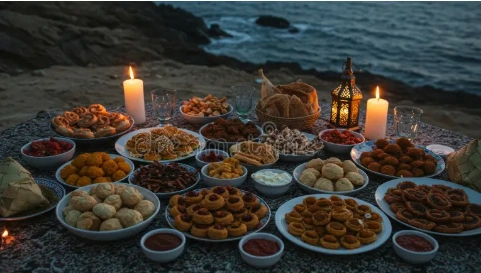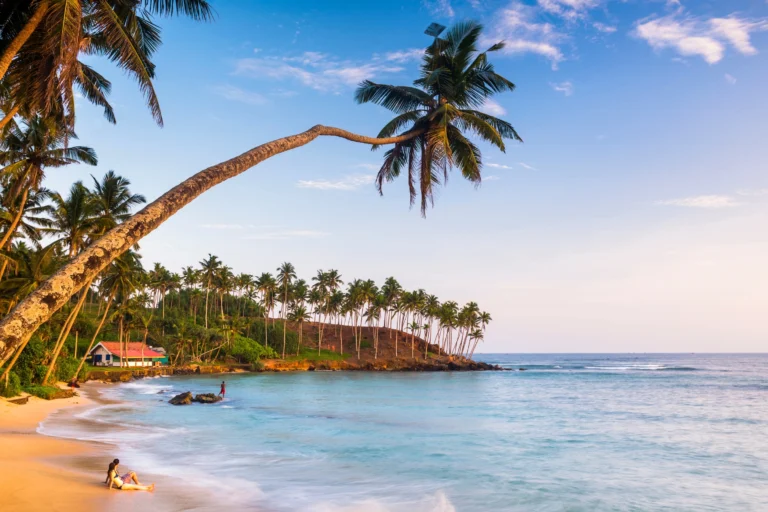Sri Lanka’s Hidden Food: Beyond Rice & Curry
When you think of Sri Lankan food, the first thing that probably comes to mind is the classic rice and curry. And yes, it’s a national staple, enjoyed daily in every corner of the island. But here’s the secret—Sri Lanka’s food culture is much bigger, bolder, and far more diverse than just one dish. Beyond the steaming plates of rice lies a culinary treasure chest filled with sizzling street snacks, coastal seafood specialties, plant-based curries, and sweet treats passed down through generations.
Thanks to its tropical climate, spice-rich soil, and centuries of cultural exchange, Sri Lanka has developed one of the most vibrant food identities in South Asia. From the fiery seafood curries of Jaffna in the north, to the coconut-rich delicacies of the southern coast, and the colorful street foods of Colombo, every region tells its story through flavor. Add influences from traders, colonizers, and neighboring India, and you’ve got a food scene that’s unique, aromatic, and truly unforgettable.
If you’re planning a trip, food is just one delicious layer of the island’s charm. For a complete picture of what to expect, check out our Sri Lanka Travel Guide.
In this blog, we’ll take you beyond the familiar and uncover the lesser-known but authentic Sri Lankan dishes—the ones locals cherish, but tourists often miss. Whether it’s the rhythmic clatter of a street vendor making Kottu Roti, the tangy punch of Ambul Thiyal (sour fish curry), or the soft sweetness of Watalappam, Sri Lanka offers a plate for every mood, every taste, and every traveler.
So, if you thought Sri Lankan cuisine was only about rice and curry, get ready to discover the hidden flavors that make this island a true food lover’s paradise.
The Heart of Sri Lankan Cuisine
Sri Lankan food is a true reflection of the island’s geography, history, and culture. Sitting right in the middle of the Indian Ocean, Sri Lanka has long been a crossroads for traders, travelers, and colonizers. Over centuries, waves of influence—from South India, the Middle East, Portugal, the Netherlands, and Britain—have blended with local traditions, creating a culinary identity that’s as diverse as the island itself.
But it’s not just history. The island’s natural bounty also shapes what’s on the plate. Surrounded by the sea, Sri Lanka is blessed with fresh seafood—from spicy crab curries in Jaffna to grilled prawns on the southern coast. Inland, fertile soil and a tropical climate mean coconut, jackfruit, plantains, and rice grow in abundance, forming the backbone of everyday meals.
And then, of course, there are the spices. Sri Lanka has been called the “Island of Spices” for good reason. The world once sailed across oceans in search of its cinnamon, which is still considered some of the finest globally. Along with cinnamon, cardamom, black pepper, cloves, nutmeg, and fiery red chili remain staples in almost every kitchen. These spices don’t just add heat; they bring depth, fragrance, and a balance of flavors that make Sri Lankan cuisine so distinctive.
At the heart of daily eating is the beloved rice and curry—a colorful spread that might include dhal (lentils), coconut sambol, spiced vegetables, and fish or chicken curry. But while rice and curry is the island’s soul food, it’s far from the full story. Step outside the traditional plate, and you’ll find an endless variety of dishes: string hoppers, kottu roti, hoppers, ambul thiyal, and sweet watalappam, just to name a few.
In short, Sri Lankan cuisine is much more than a meal—it’s a mirror of the island itself: bold, vibrant, layered with history, and bursting with flavor.
Street Food Surprises
If you really want to taste the soul of Sri Lankan cuisine, skip the fancy restaurants for a moment and head straight to the street food stalls. From roadside kottu shops to seaside vendors selling fritters, Sri Lanka’s street food is loud, flavorful, and deeply satisfying. Here are some must-try dishes that go far beyond rice and curry.
Kottu Roti – Sri Lanka’s Noisy, Tasty Fast Food
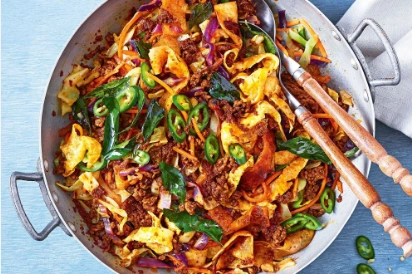
No dish represents Sri Lankan street culture better than Kottu Roti. Imagine chopped-up flatbread stir-fried with vegetables, eggs, and meat or seafood, all mixed together on a hot iron griddle. What makes kottu unforgettable isn’t just the taste but the rhythmic clanging of metal blades, as vendors chop and toss the roti at lightning speed. It’s Sri Lanka’s answer to fast food—comforting, customizable, and utterly addictive. Whether you try a spicy chicken kottu or a cheesy version loved by locals, this dish is a must for every traveler.
Isso Vadai (Prawn Fritters) – Crunchy Beachside Snack
Take a walk along Galle Face Green in Colombo, and you’ll notice vendors selling bright orange Isso Vadai. These crunchy fritters are made from spicy lentil dough topped with small prawns, then deep-fried until golden. Crispy on the outside and soft inside, isso vadai is the perfect snack to munch on while watching the sun dip into the Indian Ocean. A dash of lime juice or green chili makes it even more mouthwatering.
Hoppers (Appa & Egg Hoppers) – Sri Lanka’s Fermented Pancakes
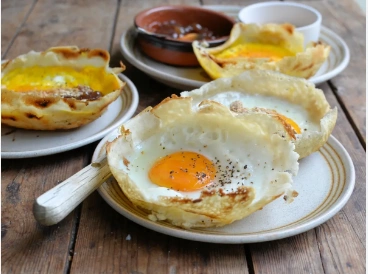
Hoppers, known locally as Appa, are one of the most iconic street foods in Sri Lanka. These bowl-shaped pancakes are made from fermented rice flour and coconut milk, cooked until the edges turn crispy while the center stays soft and fluffy. The plain hopper is simple but delicious, often paired with spicy sambol or curry. But the real favorite is the Egg Hopper—where a fresh egg is cracked into the center as it cooks. Light, tangy, and versatile, hoppers are usually eaten for breakfast or dinner, but you’ll find them sizzling away at night markets too.
Ulundu Vadai – Savory Lentil Donuts
For something hearty and savory, try Ulundu Vadai. These golden-brown “donuts” are made with urad dhal (black lentils), spiced with curry leaves, green chilies, and onions, then fried until crunchy. Unlike sweet donuts, vadai are salty, spicy, and usually served with coconut chutney or dhal curry. They’re a common snack sold at street-side tea shops and a favorite to enjoy with a hot cup of Ceylon tea.
Why Street Food Matters in Sri Lanka
Street food isn’t just about quick bites—it’s a glimpse into everyday life on the island. Each dish has a story, whether it’s kottu roti born from recycling leftover bread or hoppers that reflect centuries-old fermentation traditions. For food lovers, Sri Lanka’s streets are a feast for the senses—colorful, noisy, and unforgettable.
4. Coastal & Seafood Specialties
Being an island surrounded by the Indian Ocean, it’s no surprise that Sri Lanka has some of the most mouthwatering seafood dishes in South Asia. From fiery curries in the north to tangy, sour fish recipes in the south, the island’s coasts offer flavors as diverse as its landscapes. If you’d like to pair these dishes with stunning views, don’t miss our guide to the Best Beaches in Sri Lanka
Jaffna Crab Curry – A Fiery Northern Delicacy
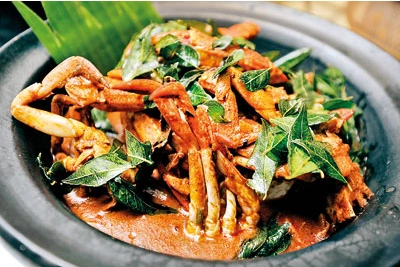
If you travel to Jaffna, the cultural heart of Sri Lanka’s north, one dish you simply cannot miss is the Jaffna Crab Curry. Famous for its bold use of chili, curry leaves, and roasted spices, this dish packs a fiery punch while letting the natural sweetness of the crab shine through. Traditionally made with lagoon crabs caught fresh from the northern waters, the curry is often served with steaming white rice or fluffy string hoppers. Locals will tell you the best way to enjoy it is with your hands—messy, yes, but absolutely worth it.
Ambul Thiyal (Sour Fish Curry) – Sri Lanka’s Signature Dish
Perhaps the most famous seafood preparation in Sri Lanka is Ambul Thiyal, also known as sour fish curry. Originating from the southern coastal regions, this dish was traditionally used as a way to preserve fish. Cubes of firm fish (often tuna) are simmered in a blend of roasted spices, black pepper, and most importantly, goraka (a dried fruit that adds a tangy, smoky flavor). The result is a dark, rich curry that keeps for days without refrigeration—a practical invention that evolved into a beloved national dish.
Squid Curry & Cuttlefish Fry – Coastal Comfort Foods
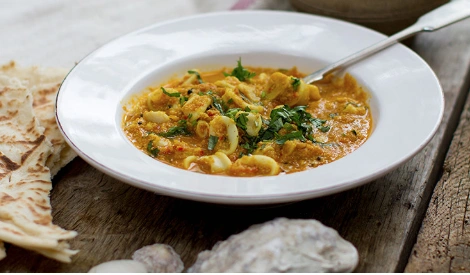
Along the beaches of Batticaloa, Negombo, and Mirissa, seafood lovers will find endless variations of squid curry and cuttlefish fry. Squid is usually cooked in a spicy coconut milk gravy, with hints of turmeric, garlic, and curry powder. Cuttlefish, on the other hand, is often marinated with chili, lime, and salt before being deep-fried until crisp. These dishes are favorites at seaside shacks where the catch of the day is transformed into plates of pure comfort. Paired with a glass of chilled ginger beer or a serving of coconut sambol, they taste like the ocean on a plate.
Regional Variations: East vs. South Coast
Sri Lanka’s regional food culture plays a big role in how seafood is prepared:
- South Coast (Galle, Matara, Tangalle): Seafood dishes here often lean on coconut milk bases, creating creamy, fragrant curries. Ambul thiyal is a southern staple.
- East Coast (Batticaloa, Trincomalee): Tamil influences bring spicier, sharper flavors with heavy use of chili, pepper, and tamarind. Dishes here are more fiery compared to the mellow coconut-based curries of the south.
- West Coast (Negombo): Known for its fishing community, Negombo offers Portuguese-inspired flavors, including seafood stews and pickled fish.
This diversity means that even the same fish cooked in different regions tastes completely unique, giving travelers a reason to explore the whole island through its food.
5. Vegetarian & Plant-Based Delights
While Sri Lanka is world-famous for its seafood curries and meaty rice accompaniments, the island is also a paradise for vegetarians and vegans. Thanks to its tropical climate and farming traditions, fresh vegetables, fruits, and leafy greens are everywhere, turning simple ingredients into flavorful dishes. Many Sri Lankan vegetarian recipes are not only authentic and traditional but also naturally plant-based—making them a hidden gem for global food lovers.
Jackfruit Curry (Polos) – A Vegan-Friendly Classic
If there’s one plant-based dish that defines Sri Lankan cooking, it’s jackfruit curry, locally known as polos. Made from young, unripe jackfruit, this curry has a meaty, fibrous texture that makes it a perfect alternative to meat. Cooked with roasted curry powder, cinnamon, cloves, and coconut milk, polos is rich, hearty, and absolutely satisfying. For vegans visiting Sri Lanka, this dish is often the star of the table because it delivers both protein-like bite and bold flavor without any animal products.
Gotu Kola Sambol – A Refreshing Herbal Salad
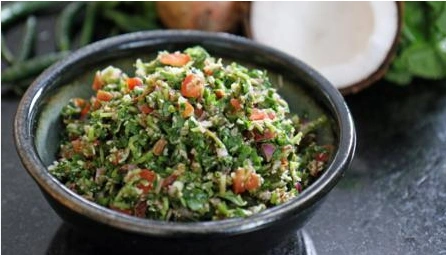
On the lighter side, Gotu Kola Sambol is a staple in Sri Lankan households. Gotu kola, also known as centella asiatica, is a medicinal herb with a slightly bitter, refreshing taste. Finely shredded leaves are mixed with grated coconut, lime juice, onion, and a touch of chili, creating a vibrant green salad that balances heavier curries. Beyond flavor, locals believe it improves memory, boosts immunity, and keeps the body cool in Sri Lanka’s hot climate—making it more than just food, but also wellness on a plate.
Pumpkin Curry & Beetroot Curry – Underrated Treasures
While rice and curry spreads often include 5–7 side dishes, pumpkin curry and beetroot curry are often the unsung heroes. Pumpkin curry is creamy, mildly spiced, and slightly sweet, pairing beautifully with fiery dishes like dhal curry or chicken curry. Beetroot curry, on the other hand, is vibrant in color and taste—earthy, tangy, and often cooked with coconut milk. Together, these curries showcase how Sri Lankan home cooking transforms humble vegetables into deeply flavorful meals.
Mallung (Leafy Greens Stir-fry) – Simple, Healthy & Traditional
A classic Sri Lankan vegetarian dish is mallung, a quick stir-fry of finely chopped leafy greens with coconut, turmeric, onions, and a hint of chili. Greens like gotu kola, kankun (water spinach), or murunga (drumstick leaves) are commonly used. Mallung is light, nutrient-rich, and often eaten daily as part of a balanced diet. It’s one of those dishes that may seem simple but represents the soul of Sri Lankan food culture—fresh, seasonal, and healthy.
6. Breads, Snacks & Short Eats
When you travel through Sri Lanka, you’ll quickly notice that food isn’t just about main meals—it’s about snacking in between. Locally known as “short eats,” these snacks are sold in bakeries, roadside stalls, and even on buses. Affordable, filling, and packed with flavor, Sri Lankan short eats represent the island’s love for quick bites that still deliver big taste.
Fish Buns – The Bakery Staple
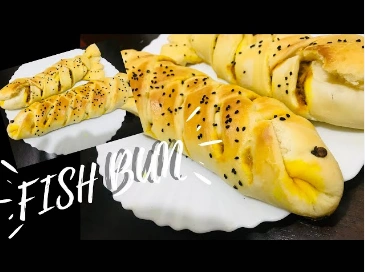
Walk into any Sri Lankan bakery and you’ll smell the comforting aroma of fish buns. Shaped like little pillows of bread, these buns are stuffed with a spicy mixture of tuna, onions, chili, and sometimes potatoes. Soft on the outside and fiery on the inside, fish buns are the go-to snack for school kids, office workers, and travelers alike. They’re not only cheap and satisfying but also a must-try introduction to Sri Lanka’s snack culture.
Parippu Vadai – Crispy Lentil Fritters
Another beloved short eat is Parippu Vadai, also called Masala Vadai. Made from ground red lentils mixed with onions, curry leaves, chili, and spices, these fritters are deep-fried until golden brown and crispy. Commonly sold by street vendors and tea shops, Parippu Vadai is crunchy on the outside yet soft and flavorful inside. It pairs perfectly with a hot cup of Sri Lankan milk tea, making it a classic tea-time snack.
Stuffed Rotis – Flatbread with a Fiery Twist
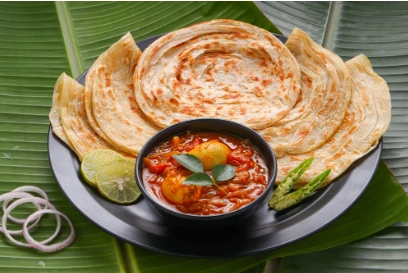
While plain roti is common in Sri Lanka, the real treat is the stuffed roti. These soft flatbreads are filled with spicy mixtures—often fish, chicken, or vegetable curry—and then pan-fried until golden. They’re portable, tasty, and filling, which makes them a favorite for long journeys and lunch breaks. Stuffed rotis showcase how Sri Lankan cooks take something simple and turn it into a snack full of character.
Sri Lankan Patties & Cutlets – Bite-Sized Perfection
If you’re looking for finger food, patties and cutlets are where Sri Lanka shines. Patties are crescent-shaped pastries filled with spicy meat, fish, or vegetables, then baked or fried. Cutlets, on the other hand, are round, breadcrumb-coated balls stuffed with tuna or potatoes and deep-fried to perfection. Both are crunchy on the outside and bursting with flavor inside—perfect for evening tea or as appetizers at local gatherings.
7. Sweet Treats & Desserts
Sri Lankan cuisine doesn’t end with fiery curries or crunchy snacks—it also has a rich tradition of sweets and desserts that highlight the island’s love for coconut, jaggery, and tropical flavors. Many of these sweet treats are linked to festivals, family gatherings, and temple offerings, making them a cultural as well as a culinary delight. If you have a sweet tooth, here are a few must-try Sri Lankan desserts beyond the usual fruit platters.
Watalappam – The King of Sri Lankan Desserts
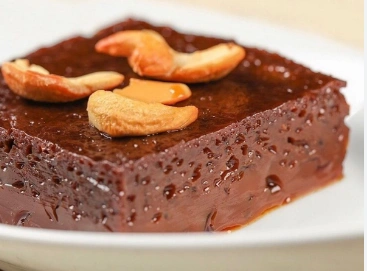
No list of Sri Lankan sweets is complete without Watalappam, a silky coconut custard pudding. Made with coconut milk, jaggery (palm sugar), eggs, and spices like cardamom and nutmeg, this dessert is often served at weddings, religious feasts, and family celebrations. Its caramel-like sweetness and creamy texture make it irresistible. Some even call it “Sri Lanka’s crème caramel”, but with an exotic island twist.
Kevum (Oil Cake) – A Festive Favorite
During Sinhala and Tamil New Year in April, almost every Sri Lankan home prepares Kevum. This deep-fried sweet is made from rice flour and treacle (a syrup from kithul palm). Shaped like little diamonds or ovals, Kevum has a chewy, slightly crispy texture that makes it a festival staple. It’s not just a snack—it’s a symbol of hospitality and tradition, offered to guests during special occasions.
Kiri Toffee – Sweet & Creamy Indulgence
If you grew up in Sri Lanka, chances are you’ve had Kiri Toffee at school parties, weddings, or temple fairs. This condensed milk fudge is made with milk, sugar, and sometimes cashew nuts, cooked down into a creamy block and then cut into squares. It’s rich, sweet, and melt-in-the-mouth delicious—a perfect balance between simple ingredients and comforting taste.
Peni Walalu (Honey Rings) – Crunchy & Sticky Sweetness
Known as “unduwal” in some regions, Peni Walalu are spiral-shaped sweets made from urad dal batter, deep-fried until crisp, and then dipped in thick treacle or honey. With their golden color and syrupy glaze, they’re a feast for the eyes and the taste buds. Often found at religious festivals and street stalls, these honey rings are crunchy, sticky, and utterly addictive.
8. Drinks to Complete the Meal
No Sri Lankan food journey is complete without sipping on the island’s refreshing and unique drinks. From tropical fruit juices to world-famous Ceylon tea, beverages in Sri Lanka aren’t just thirst-quenchers—they’re part of the cultural fabric. Whether you’re cooling off after a spicy curry or relaxing at sunset by the beach, these traditional drinks perfectly complement the country’s diverse cuisine.
King Coconut Water – Nature’s Own Drink
Forget bottled sodas—King Coconut Water (Thambili) is Sri Lanka’s ultimate natural refreshment. Bright orange on the outside and packed with electrolytes, this drink is sold everywhere, from roadside stalls to beach shacks. It’s slightly sweeter than regular coconut water and is not only hydrating but also great for digestion after heavy rice & curry meals. Locals and travelers alike swear by it as the healthiest way to beat the island’s tropical heat.
Toddy (Fermented Palm Drink) – Traditional Brew
For something stronger, Sri Lanka offers Toddy, a naturally fermented drink tapped from the sap of coconut or kithul palms. Slightly fizzy, mildly alcoholic, and best enjoyed fresh, it has been part of Sri Lankan village life for centuries. Some regions also distill it further to make Arrack, a stronger spirit with a unique coconut essence. While not always easy for tourists to find, it’s one of those authentic local beverages that connects food with tradition.
Sri Lankan Black Tea with Milk – The Pride of Ceylon
Sri Lanka is globally famous for its Ceylon tea, grown in the lush hill country around Nuwara Eliya, Kandy, and Ella. While pure black tea is a worldwide export, locals often enjoy it with fresh milk and sugar, making it smooth, creamy, and comforting. Tea time is more than just a drink in Sri Lanka—it’s a social ritual, where friends and family gather around steaming cups. A sip of Ceylon tea, whether plain or with milk, truly embodies the island’s heritage.
Woodapple Juice – Exotic & Flavorful
If you’re adventurous with flavors, Woodapple Juice (Divul) is a must-try. The fruit looks rough and hard on the outside, but inside it has a tangy, sweet-sour pulp that’s blended into a thick, brownish drink. Rich in fiber and vitamins, it’s both refreshing and filling. Many Sri Lankans also add jaggery to balance the tang. For first-timers, it might taste unusual, but it’s one of those authentic Sri Lankan experiences you won’t forget.
9. Regional Food Diversity
Sri Lanka’s cuisine is as diverse as its landscapes. Every region adds its own flavor, shaped by geography, history, and cultural influences. From the fiery curries of the north to the seafood-heavy south and the fusion dishes of Colombo, traveling across the island feels like a moving feast. Let’s explore the regional food specialties that make Sri Lanka such a unique culinary destination.
Jaffna – Spicy Northern Flavors
The northern city of Jaffna is known for its bold and fiery cuisine. Influenced by South Indian Tamil traditions, Jaffna dishes are loaded with red chili, tamarind, and aromatic spices. A must-try here is the famous Jaffna Crab Curry, a rich, spicy seafood dish often paired with string hoppers or rice. You’ll also find unique vegetarian recipes, such as murungakkai (drumstick) curry and Jaffna-style Kool, a seafood and vegetable broth that’s deeply rooted in Tamil culture.
Galle & Southern Coast – Seafood Dominance
Down south, the coastal city of Galle and its neighboring towns like Mirissa and Unawatuna showcase Sri Lanka’s seafood magic. From Ambul Thiyal (sour fish curry) to crispy fried cuttlefish and prawn specialties, the southern coast is heaven for seafood lovers. Coconut milk is used generously here, balancing the spice with a creamy, coastal flavor. Beachside cafes serve fresh catches daily, making this region one of the best places to enjoy authentic Sri Lankan seafood.
Kandy & Hill Country – Plant-Based and Mild Dishes
In contrast to the coasts, the central hill country around Kandy, Nuwara Eliya, and Ella is famous for its vegetarian and plant-based cuisine. Thanks to fertile highland soil, locals enjoy a variety of fresh vegetables, lentils, and leafy greens. Dishes like pumpkin curry, jackfruit curry (polos), and mallung (stir-fried greens) are staples here. The cooler climate also makes it the perfect region to enjoy Sri Lanka’s world-renowned Ceylon tea, often paired with bakery snacks. The flavors are typically milder than Jaffna or Galle, reflecting a softer, more earthy food culture.
And if you’re exploring this region, don’t miss our detailed guide to Hiking in Sri Lanka for the best treks through tea plantations and mountain trails.
Colombo – Fusion and Modern Takes
As the capital and most cosmopolitan city, Colombo brings together every flavor of Sri Lanka, plus international twists. You’ll find everything from traditional rice & curry lunch packets to street food kottu roti and high-end restaurants serving fusion dishes. Colombo is also where many Sri Lankan favorites get a modern makeover—think Sri Lankan-style burgers with seeni sambol, or crab curry served fine-dining style. This region reflects how tradition and modernity blend in the island’s food scene, making it the best place to taste Sri Lanka’s culinary evolution.
10. Where to Find These Hidden Gems
Knowing what to eat in Sri Lanka is only half the story — the real question is where to find these authentic dishes. While big restaurants and hotels often cater to tourists, the true heart of Sri Lankan cuisine lives in street corners, small rice shops, family kitchens, and bustling markets. If you want to taste food the way locals do, here’s where to start your hunt for Sri Lanka’s hidden culinary treasures.
Local Street Vendors
Nothing captures the soul of Sri Lankan food like its street food culture. On almost every street, you’ll find vendors frying up isso vadai (prawn fritters) by the beach, making sizzling kottu roti with its signature clanging sound, or serving hot hoppers late into the night. Street vendors are the best place to enjoy cheap, fresh, and flavorful snacks. Popular spots include Galle Face Green in Colombo, Kandy’s central streets, and coastal towns where seafood stalls line the shore.
Traditional “Bath Kades” (Rice Shops)
The word bath means rice, and bath kades (small rice shops) are where locals grab their everyday meals. These humble eateries serve a plate of steamed rice with a mix of curries, often including dhal (lentils), sambols, and one or two meat or fish options. Prices are low, portions are generous, and the flavors are as authentic as they get.
If you’re traveling through smaller towns or rural areas, don’t miss out on these rice shops — they’re the best places to sample homemade-style Sri Lankan curries that never make it onto hotel menus.
Family-Run Guesthouses
For a more intimate food experience, stay at a family-run guesthouse or homestay. Many of these offer home-cooked meals prepared with recipes passed down through generations. From jackfruit curry (polos) to fresh sambols made with garden herbs, you’ll taste dishes that tourists rarely encounter. Guesthouse dining also gives you the chance to learn about local cooking traditions and sometimes even join in for a hands-on cooking session.
Weekend Markets & Festivals
To explore Sri Lanka’s seasonal and regional specialties, head to the local weekend markets (pola) or attend a cultural festival. Markets overflow with tropical fruits like woodapple, rambutan, and jackfruit, along with fresh spices and ready-to-eat snacks such as parippu vadai and sweet kevum (oil cakes).
Festivals, especially Sinhala & Tamil New Year (Avurudu), showcase the country’s festive treats, from kiri toffee to peni walalu (honey rings). These events are not just about food — they’re windows into the social and cultural fabric of Sri Lanka.
If you only eat at hotels, you’ll miss the soul of Sri Lankan cuisine. The best way to discover hidden food gems in Sri Lanka is to step off the tourist trail — into local markets, guesthouses, and small eateries where every dish tells a story.
11. Tips for Food Travelers in Sri Lanka
Traveling to Sri Lanka is not just about seeing breathtaking landscapes — it’s also about tasting authentic Sri Lankan food. But if you’re new to the island’s bold spices, unique eating traditions, and street food culture, a little preparation goes a long way. Here are some essential tips for food travelers in Sri Lanka to help you eat like a local, stay safe, and enjoy every bite.
Eating Like a Local
One of the most memorable parts of a Sri Lankan meal is how it’s eaten. Locals often use their right hand to mix and eat rice and curry. At first, it might feel unusual, but it’s considered the most authentic way to experience the flavors. In traditional setups, food may also be served on a banana leaf, especially during festivals or special occasions. The leaf not only adds aroma but is also eco-friendly.
Hygiene & Food Safety Tips
Sri Lankan street food is delicious, but first-time visitors should keep a few hygiene tips in mind:
- Choose busy stalls or vendors — high turnover means fresher food.
- Drink bottled or boiled water, and avoid ice unless you’re sure it’s made with clean water.
- Peel your own fruits when buying from markets to avoid contamination.
- Stick to freshly cooked items like kottu roti, hoppers, and vadai, instead of pre-cooked foods sitting for hours.
How to Ask for “Less Spicy”
Sri Lankan cuisine is famous for its bold use of chili and pepper. While locals enjoy fiery dishes like Jaffna crab curry or ambule thiyal, not every traveler can handle that heat. Thankfully, you can ask for “maese wenna” (less spicy) when ordering. Most restaurants and homestays understand tourist preferences and will adjust the spice level when requested.
Pro tip: If you’re new to spicy food, start with milder curries like dhal (lentils), pumpkin curry, or kiri hodi (coconut milk gravy) before venturing into the hotter ones.
See also: Climbing Adam’s Peak in Sri Lanka: A Complete Travel Guide
Best Times & Places for Seasonal Dishes
Sri Lanka’s food culture is closely tied to seasons, festivals, and regions. To enjoy the freshest and most authentic meals, keep these in mind:
- April (Sinhala & Tamil New Year) – try traditional sweets like kevum, peni walalu, and kokis.
- Monsoon season (May–September on the southwest coast, October–February on the east coast) – great time for fresh seafood, as different coastal areas bring in different catches.
- Markets in the morning – vegetables, fruits, and short eats are freshest early in the day.
- Festivals and religious events – often feature unique sweets, temple food, and community feasts.
12. Conclusion
When most people think of Sri Lankan cuisine, the first image that comes to mind is a plate of rice and curry. While it’s true that this staple defines everyday meals, Sri Lanka’s culinary identity is far richer and more diverse than many imagine. From fiery Jaffna crab curry in the north to crispy isso vadai sold on golden beaches, from comforting jackfruit curry to sweet treats like watalappam, the island’s food culture is an endless journey of flavors.
Sri Lanka’s cuisine tells the story of its geography, history, and traditions — blending spices, seasonal produce, seafood, and centuries of cultural influences. What makes it truly special is how every region, every street stall, and every family kitchen brings its own twist.
So, if you’re planning your food adventure, don’t stop at the “tourist dishes” or stick only to hotel buffets. Step into a bustling street market, try a hopper at a roadside kade, or share a home-cooked curry at a family-run guesthouse. You’ll quickly realize that Sri Lankan food is not just a meal — it’s an experience of culture, warmth, and connection.
Ready to taste Sri Lanka beyond the usual? Start with these local favorites and let every bite tell you a story.

